
Table of Contents
Advertisement
Advertisement
Table of Contents

Summary of Contents for Proceq RockSchmidt
- Page 1 ROCK SCHMIDT OPERATING INSTRUCTIONS Made in Switzerland...
-
Page 2: Table Of Contents
1.3 Safety Instructions ...................5 1.4 Labelling ....................5 2. Getting Started ..................6 2.1 RockSchmidt Basics ................6 2.2 Components of the RockSchmidt ............7 2.3 The RockSchmidt Display ................8 2.4 Philosophy of the User-Interface ..............8 2.5 Sample Preparation ..................9 2.6 Correct use of the Hammer ..............9 3. -
Page 3: Safety And Liability
1.2 Liability and Warranty 9.7 Custom Statistics ..................22 Proceq’s “General Terms and Conditions of Sale and Delivery” apply in all cases. Warranty and li- 9.8 Custom Curves ..................22 ability claims arising from personal injury and damage to property cannot be upheld if they are due to one or more of the following causes: •... -
Page 4: Getting Started
In the case of a low battery alert, you can still record approximately 100-200 impacts. To recharge, connect the RockSchmidt to the charger or to a PC. Approximately 90 minutes of charging will bring your RockSchmidt to its full capacity. -
Page 5: The Rockschmidt Display
Please note however, that this may affect the test result. Further information about this is contained in a research paper of the University of Oxford via the Proceq website “The use of the Schmidt Hammer and Equotip for rock hardness assessment in geomorphology and heritage If there is a battery or low impact energy alert (see chapter 8), it is displayed between the unit symbol science: a comparative analysis”. -
Page 6: Optional Settings
NOTE! The uncorrected R-values are saved as part of the test result. The correction maturely if any 10 subsequent readings differ by ±2. On completion the RockSchmidt calculates the factor is applied to the calculated average and can be posthumously corrected in mean and the range. -
Page 7: Checking The Current Settings
Prediction of penetration rates for tunnel boring machines and rotary drum cutters. • Testing on cores and blocks. Further information, application notes and a list of reference papers may be found on the Proceq Confirm or cancel the action website. -
Page 8: Delete The Last Impact (Outlier)
The last 20 series recorded can be reviewed in the data list. The memory is capable of storing many more tion is made to UCS or E-modulus. series (See chapter 7). All series stored on the RockSchmidt can be downloaded to the PC for review. Select review list. -
Page 9: Technical Specifications
ISRM recommend the use of rebound hammers for UCS within the range 20 – 150 MPa. Self test function The RockSchmidt performs a number of self test checks and gives an alert when there is a problem. ASTM recommend an upper UCS limit of 100 MPa. -
Page 10: Rocklink
The menu item “File – Application settings” allows the user to select the language and the date and time format to be used. Connecting to the RockSchmidt Connect your RockSchmidt to a USB port, then click on the icon to bring up the fol- lowing window: Leave the settings as default or if you know the COM port you can en- ter it manually. -
Page 11: Adjusting The Settings
Each of the settings (statistics method, conversion curve, unit and correction factor) that were used in The menu item “Edit – Delete” allows you to delete one or more selected series from the down- the RockSchmidt at the time of the measurement series can be adjusted subsequently in RockLink. loaded data. -
Page 12: Custom Statistics
You can store up to 3 custom curves at a time on the RockSchmidt. Choose the location of the curve (C1, C2, or C3) and upload. A warning window is displayed. Click on “Yes” to complete the action. - Page 13 Five Continent International Mansion, No. 807 Zhao Jia Bang Road Shanghai 200032 China Phone +86-21-6317-7479 +86-21-6317-5015 info-china@proceq.com Subject to change. Copyright © 2017 by Proceq SA, Schwerzenbach. All rights reserved. Part Number: 820 343 01E ver 5 2017 © 2017 Proceq SA...
Need help?
Do you have a question about the RockSchmidt and is the answer not in the manual?
Questions and answers